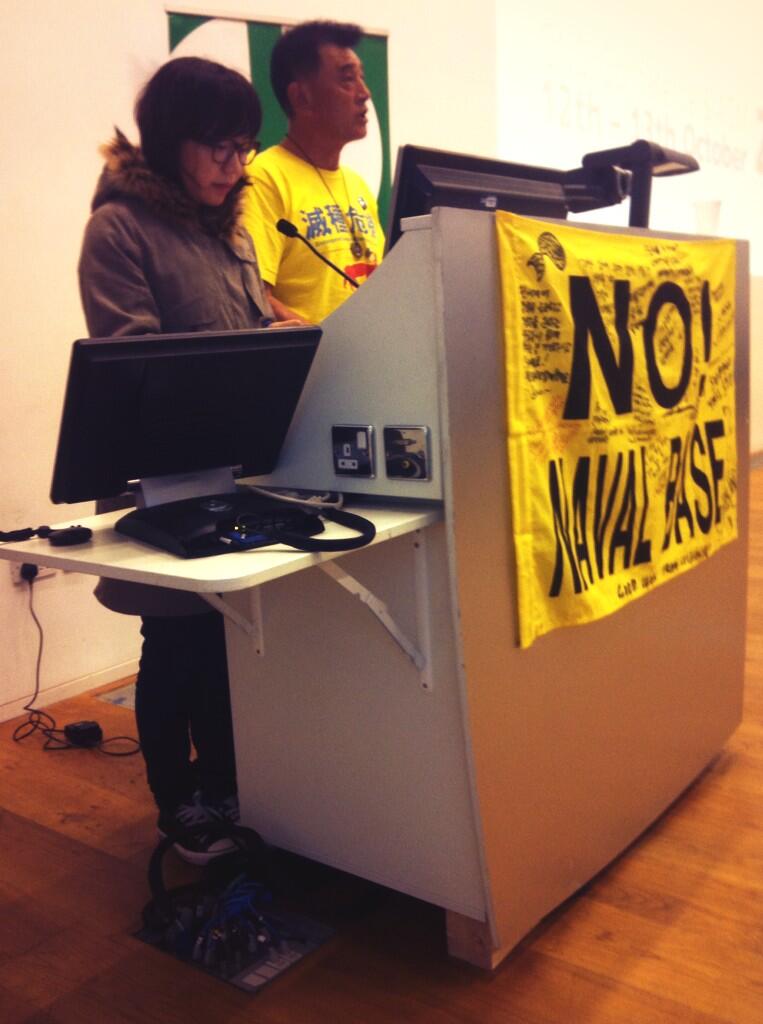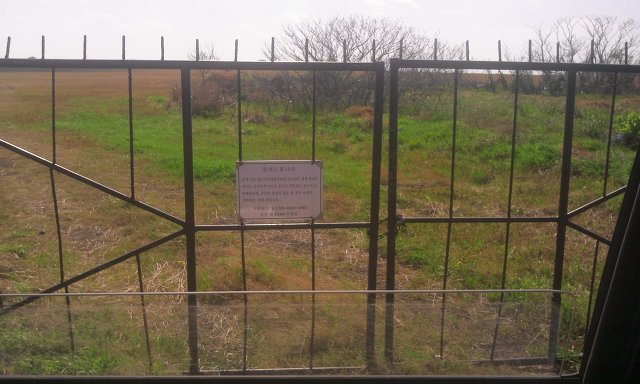In this month’s issue:
Yang Yoon-Mo Free at last, April 3rd Remembrances, 4 catholics arrested, letter from David Hartsough, Trial Updates, Peace for the Sea Camp, Peace Book Cafe anniversary, international solidarity, and more!
Save Jeju Now
No War Base on the Island of Peace
Tag: 4.3 Massacre
-
Alchemy On Jeju Island
Reblogged with permission from: Alchemy On Jeju Island | by Koohan Paik *
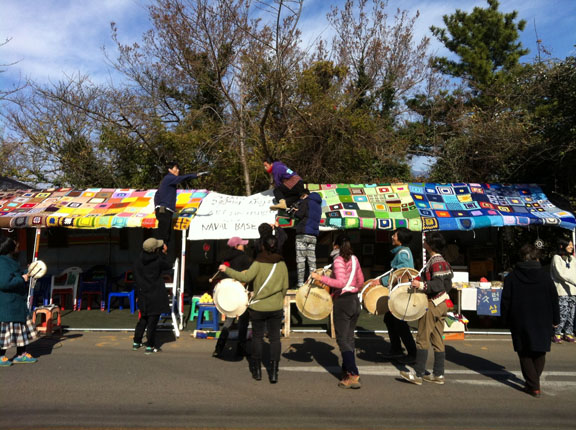
Gangjeong villagers and activists decorate the streets with colorful woolen squares knitted by supporters of the anti-base struggle. Traditional drummers play in the foreground. I recently spoke with two members of Veterans for Peace, who had become involved with Korea issues in only the past few years. Each of them came to know Korea through their support for the Gangjeong villagers who have been battling, for nearly eight years straight, construction of a huge, high-tech navy base being built on their Jeju-Island coastline. Both men said that before Jeju, their work with northeast Asia was Japan-centered, and that “no one ever talked about Korea.” But through their engagement with Gangjeong, they have learned about the April 3 massacre, about the unending Korean War, about the unprecedented tonnage of bombs that the U.S. levied upon the Korean people in the early 1950s, and about modern Korean history, in general. Today, they recognize that the Korean War was certainly as consequential in U.S. history as the war in Vietnam. It now perplexes them that Korea had been effectively erased from the books.
The sad truth is, the vast majority of even the most progressive Americans know very little about Korea, let alone that the U.S. has been at war with it for the past 60 years. Many don’t even know where Korea is. This absurd knowledge void presents a challenge so daunting for those working toward unification, that nothing short of alchemy would seem to hold any promise for peace on the peninsula.
On the other hand, it appears that the tragedy unfolding at Gangjeong village might offer just the sort of alchemy that could conjure Korea into the wider consciousness. Ecumenical groups, environmental groups, artists, lawyers, social workers, peace-studies groups, student groups, indigenous-rights groups, and food-sovereignty groups have all passed through the tiny village whose fame is now of global proportion. Numerous articles on the villagers’ plight have been published in Europe, South America, the Asia-Pacific and the U.S. Last summer, I was at the San Francisco airport with Gangjeong’s charismatic Mayor Kang Dong-kyun on his first foray outside of northeast Asia, when a woman behind him in line said, “Aren’t you Mayor Kang? From Gangjeong village?” It turned out she had studied Gangjeong as part of a peace-studies program in Virginia, and recognized him from internet videos. Little Gangjeong has put Korea “on the map” and affirms that the Korean War is indeed alive and well.
Then, in fall of 2013, the City of Berkeley, California, was the first city in the world to formally declare its support of the Gangjeong villagers in the form of a resolution opposing the navy base. Shortly thereafter, in Madison, Wisconsin, the National Board of Veterans for Peace passed a similar resolution to “Stop the Second U.S. Assault on Jeju Island.” The document not only describes what is at stake if the base project is allowed to proceed, but also gives historical context, such as the 1948 genocide on Jeju and how the ever-increasing militarization of Korea violates the 1953 Armistice. It reads like an overview of modern Korean history vis a vis the United States.
One of the most poetic declarations in support of the Jeju struggle was made by a group of Afghani peace activists based in Kabul who have established a Skype relationship with their counterparts in Gangjeong. They write: “We are confident that if ordinary Chinese or North Koreans ever gave you trouble, you would have tea with them, using your imagination and citizen diplomacy to calm the troubles, non-violent paths which are far more effective and kind, and a far better use of tax-payer money (it takes no tax-payer money to drink tea!) than the multi-million premises, personnel and war equipment.”
The global draw of the Gangjeong village struggle owes much to the fact that the land, water, heritage and culture at stake have already garnered international recognition. Gangjeong’s culture and environment have earned UNESCO designations. It is one of Korea’s few remaining traditional, indigenous villages; it contains some of Korea’s best farms and richest soil, its purest water and its haenyo diver tradition; its coast was home to Korea’s only pod of dolphins and one of the world’s finest, soft-coral forests (now being dredged); and its 1,900 residents practice authentic local democracy.
True, all these elements attract an international crowd. But the most enduring appeal of the humble village sits squarely in its remarkable community spirit. The community is comprised of an eclectic mix of villagers, clergy and Seoul activists, who strategize and carry out campaign after campaign. There are cooks, videographers, and kayakers who monitor environmental violations by construction crews. There are people setting up for “Hundred Bows” every morning, or for a music concert in the evening. There are people manning the Peace Center, ready to welcome new arrivals disembarked off the public bus steps away. There are people printing up information pamphlets to disseminate at any one of the big, international conventions that regularly take place on Jeju. It is no exaggeration to say that the village is as fueled on dynamic love as it is by donation.
Most recently, there have been scores of knitters – yes, knitters! – sitting crosslegged in the Peace Center for hours at a time, lashing together enormous woolen quilts in rainbow hues, out of over a thousand knitted squares sent to them by supporters from all over Korea. December 2013 in Gangjeong saw the streets festooned with the quilts, and even the skeletal trees were given cheery, colorful “sweaters” that fit snugly over their trunks and branches. The sight of this whimsical riot of color splashed across winter’s dreary landscape, in contrast with the phalanxes of stern and smooth-faced cops who robotically pull away every protestor from blocking cement trucks, is indeed chilling — yet somehow, transcendent. Even an atheist once commented that life in Gangjeong was the closest one could come to living with God. Maybe that’s why, when visitors return to their own countries, either voluntarily or through deportation, they are compelled, almost evangelically, to “spread the word” through events, writing articles, and making films. Something special is going on in Gangjeong.
But it wasn’t always this way. Initially, the villagers were highly suspicious of outsiders, particularly those from the Korean mainland. They carried the trauma of the April 3, 1948 massacre in living memory, when the South Korean army, under U.S. orders, unleashed wholesale terror on the island and murdered at least a third of the population. Understandably, the South Korean government’s announcement that their village would be the site for a navy base only reinforced their mistrust of outsiders. In those beginning years, the Gangjeong villagers battled alone, in total obscurity. But at a certain point, with everything at stake, they had no choice but to embrace the support of mainlanders who seemed authentically sincere. One such mainlander was artist Sung-hee Choi, board member of the Global Network Against Weapons and Nuclear Power in Space and the pivotal person in exposing the struggle internationally. She started a blog, No base stories of Korea, in December 2008 which first introduced Gangjeong outside of Korea in 2009. Choi moved to Gangjeong in 2010 and has been there ever since.
Update: Environmental Destruction, Incarceration, Depression
Today, almost eight years since the announcement of the base project, the Gangjeong coastline is unrecognizable, carpeted with enormous stacked cement forms of varying shapes and sizes that resemble a giant’s erector set. The 86 species of seaweed and over 500 species of mollusks – once food for the village – have all but perished. The sea is no longer a clear dark blue, but grayish brown. Gargantuan concrete cubes called “caissons,” 10 stories high apiece, sit on the ocean floor where biodiverse coral habitats once thrived. On land, an enormous rebar mold for manufacturing the caissons looms hideously over the horizon. The rumbling and scraping sounds of construction fill the air night and day. The base is slated to start operation in 2015.To add insult to injury, resistance leaders are jailed for months on end, often caught in a revolving door of multiple prison sentences. Currently, three beloved individuals languish unjustly behind bars: 22-year-old Kim Eun-hye, Brother Park Do-hyun, and film critic Yang Yoon-mo, who has been incarcerated for about a year.
Depression and suicidal tendencies have skyrocketed in Gangjeong, according to the Jeju media. Women weep in the streets. Often, there are scant visitors to boost morale (and the visitors really do make a positive difference). During the winter when it’s off-season for tourists, they feel alone and helpless against the cranes, dredges and cops of the transnational defense industry’s destructive juggernaut.
Community Creativity
Someone once asked Gangjeong Mayor Kang Dong-kyun, “What keeps you going?” He said, “Knowing that this is not just for me, not just for my children, or my children’s children, or for my ancestors. It is for world peace.” But Mayor Kang left out a key component as to how the villagers have maintained their resilience for as long as they have: through dance. As silly as it may sound, a series of four wacky dances that celebrate Gangjeong has served as an indispensable catharsis ritual that ends each day. The villagers will also spontaneously break out into the Gangjeong dances when times get tough, such as what happened upon the tearful announcement at the IUCN convention that a resolution to stop base construction had been defeated. It’s how they let off steam so they can keep going.In a certain sense, Gangjeong uses creativity as a weapon in psychic self-defense. Once the villagers mounted a film festival of anti-war videos directly in the gaze of a row of riot cops surrounding the base. It is as if, for every harsh blow, every broken bone, every dead dolphin, every prison sentence, and every fine levied upon them, they emerge with a surprising rejoinder of equal, positive force. Recently they lined the village streets with six-foot high stacks of books, 30,000 in all, creating both political art and a library al fresco — a stunning visual juxtaposition against the squadrons of police.
The Gandhi-esque villagers seem to have captured the hearts and imaginations of the world. When a former attorney with the Clinton administration came to Gangjeong, he marveled, “In the face of brutal opposition, they display only grace and persistence.” When a German IUCN bioethicist spent several days in the village, he remarked, “their joy is infectious.” When a Hollywood film director was asked what he liked best about his visit to Gangjeong, he said, “The dancing.” At the core of such astonishing creativity is – again — the community. Perhaps this is the alchemy that can heal all of Korea.
One could say that the villagers have metamorphosed Gangjeong into a premiere destination for political tourism. Gangjeong is an excellent place for foreigners starting at a zero knowledge base, to learn about Korea’s place in history and in the region. And the benefits are reciprocal; while visitors learn about Korea, they invariably take their lessons home and spread the information, which, in turn, supports the movement. Professor Rob Fletcher gave a seminar at Costa Rica’s University for Peace on the base struggle. Victoria Tauli-Corpuz, one of the original drafters of the United Nations Declaration on the Rights of Indigenous People, has been in communication with villagers about staking out their identities as indigenous Tamna (which could lead to advantages through processes at the UN). British attorney Harry Jonas wrote a case history of Gangjeong as an example of how legal constructs violate what he calls “natural justice.” Such developments have given new hope to villagers who have lost all faith in their own government.
As a result of such exchanges, villagers have become extraordinarily sophisticated about other Asia-Pacific islands also under assault by militarization and the Pentagon’s “Pacific Pivot.” Solidarity has been built with Taiwan, Okinawa, Guam, Hawaii, and elsewhere. Now, when President Park Geun-hye echoes her father’s dream of turning Jeju into “Korea’s Hawaii,” a tourist mecca complete with navy base, the villagers steadfastly oppose. They do not want to see militarization kill all life in their sea, as it did in Pearl Harbor, which is now a toxic Superfund site. Like all indigenous people, they know that without their natural resources, they die — economically, culturally, spiritually.
Recently, an American pragmatist looked out at the machines bulldozing the coast and said to me, in a defeated tone, “You’re not going to stop the base.” He’s likely right. But maybe I’m not looking only for linear cause-and-effect results – like I used to. The way of life here has connected me with my own humanity and the humanity of others. Just as its residents have transformed this physically disfigured place into a village of spiritual beauty, I, too, have been transformed. And I know many others who have been similarly changed. Gangjeong is like the Chinese character that means not only “crisis,” but also “opportunity.”
Koohan Paik, who was raised in Korea during the Park Chung-Hee era, is a journalist, media educator, and Campaign Director of the Asia-Pacific program at the International Forum on Globalization. In 2011 and 2013, she helped to organize the Moana Nui conference in Honolulu, which brought together international activists, scholars, politicians and artists to consolidate Asia-Pacific discourse as it relates to geopolitics, resource depletion, human rights and global trade. She is the co-author of “The Superferry Chronicles: Hawaii’s Uprising Against Militarism, Commercialism and the Desecration of the Earth,” and has written on militarism in the Asia-Pacific for The Nation, Progressive, and other publications.
*Reblogged posts do not necessarily reflect the opinions or views of Save Jeju Now
-
Mayor Kang from Jeju speaks about the struggle against the US naval base
See also this interview with Mayor Kang by Asian Global Impact on Oct. 18
From Oct. 8 to 17, 2013, Gangjeong village mayor has joined the Human Rights defenders’ forum in Dublin, Ireland, as well as traveled London, Leeds and Paris etc. Thanks so much to the organizers of his speech trip in Ireland, UK, and France.
I am Dong-Kyun Kang, the Mayor of a small village called Gangjeong in Jeju. I am so grateful for this opportunity to speak to you. It’s very meaningful. So far, I’ve heard many stories from around the world which make me very scared and worried for our descendants.
Given that fresh spring water is such a precious and scarce resource on Jeju island, the 450 year old village of Gangjeong situated in the southern part of the island was always the envy of other villages as its possession of an abundant spring water supply which always flowed freely ensured it was always ranked first among Jeju’s villages. During the construction of the naval base, many international activists have visited Gangjeong and others in the process have been denied entry and deported. Other peace activists have been prevented from leaving the country. I’m keenly aware and saddened that many have suffered from many forms of repression and for their sacrifice I feel so grateful and promise to stand with you in solidarity.
You’ve now seen that in recent history there have been two major events in Korea – in 1948 and 1950. As you are aware there was the major upheaval of the 1950 Korean War which broke out in June 25 – a tumultuous national tragedy. One could be forgiven for thinking that this was a family feud that led to the country being divided but the reality was that the war was the result of an ideological battle between the major powers at the time and Korea was its victim. This continues until the present time.
The April 3, 1948 Jeju uprising led to the brutal suppression of the population by state security forces which resulted in the massacre of the islanders of Jeju and behind the slaughter was the US government, the self-proclaimed keeper of the peace! A conservative estimate puts the number who died from the mass killings at over 30,000 out of a population of 280,000 people at that time.
Fortunately, in 2005 President Roh apologized on behalf of the state to the people of Jeju and acknowledged for the very first time the states brutal suppression and massacre of the people of Jeju. He went on to declare Jeju as an ‘island of world peace’. Peace can only be sustained through peaceful means. Peace obtained through force and violent means is not sustainable and in time will be forced to surrender to a larger force or power. However, I believe that dialogue and mutual understanding between people who work together in mutual respect to build a sustainable future is the key to a sustainable peace.
The location of Korea positioned in the middle of the Pacific Ocean and particularly the strategic location of Jeju Island is key to understanding its strategic importance to the world’s major powers. However, behind the construction of the naval base in Jeju is the US government. Will Jeju genuinely remain an island of peace or an island of military bases heightening tensions between the world’s major powers? This is a central question that needs addressing.
The naval base project is a national security project. I think one defines genuine national policy as seeking to put the interests of its citizens and their happiness and genuine well-being first and foremost. Likewise national security is not only about the state’s administration and its military but should seek to ensure genuine human security for all its citizens. Genuine national policy and national security should seek to secure the confidence and trust of all its citizens which in turn forms the true pillar and foundation for its policies. Working together hand in hand with the people should be the central tenet of its policies.
Aside from the naval base construction creating the strong possibility of a situation of crisis for Korea and Jeju into the future, the village community of Gangjeong is being destroyed with its people being evicted. With the construction of the naval base the navy claims that the national security of the state is its primary objective followed by the economic development of the region and its third objective – the navy and residents coexisting in mutual cooperation and to the benefit of all. However, the construction of the naval base rather than enhancing and bolstering national security will have the opposite effect of increasing already existing tensions between global powers in the region resulting in Jeju being caught in the crosshairs of conflict in the future. How therefore can the building of a naval base bolster regional economic development in such a tense and dangerous environment?
The state in implementing its policies should first consult the people who will likely be impacted the most and endeavour to seek the consent of its citizens through due process which is the most important consideration and an important building block of any democratic society. Even with the project underway listening courteously to and reflecting on the opinions of the other is surely important in trying to achieve real cooperation. The need for transparency in implementing state projects is paramount. However, the naval base has been enforced from the beginning without any consultation on the decision making process and devoid of any semblance of transparency leaving the Gangjeong villagers in the dark about what was going on. Those villagers opposed to the base are in the process of having their lands expropriated without any dialogue or due process of consultation. The villagers are completely perplexed and dismayed by the conflict that has arisen in their village with the naval base decision having separated families and divided parents with siblings becoming enemies and yesterday’s friends becoming today’s enemies resulting in the collapse of the community.
Fully aware of the stark implications of proceeding with plans to build the base the central government and navy planned and designed the base together with the backing of the US government. As a means of promoting the base and quashing any form of dissent, protestors have been treated with great hostility and denounced as leftists and North Korean sympathizers by the military. The brutal enforcement of the base with complete disrespect and arrogance has resulted in the military losing whatever respect it may once have had.
Together with the mobilization of the police and state power is the major issue of the lack of due legal process and the arrests of over 700 activists, charges having been filed against 400 activists with 25 cases of activists having been imprisoned to date. There has to be a fair way to resolve such conflicts but the legal system and court process has failed to provide this. With the full power of the police state brought to bear on villagers and activists alike it is undeniable that people will get hurt as they are literally being dragged away like animals battered and bruised. However the courageous and brave efforts of so many over the course of a 7 year long struggle are not in vain but are the source of a precious groundwork that is the basis for a bright future for Gangjeong and Korea alike. These continuing efforts will continue to bear fruit long into the future. The majestic natural environment of Jeju is commonly referred to as beauty inherited from the gods and is home to the UNESCO Biosphere Reserve and three UNESCO World Natural Heritage sites. In 2012 The New Wonders Foundation voted Jeju Island as one of the 7 Natural Wonders of the World. In September 2012 the World Conservation Congress opened in Jeju where it was hoped that it would promote the international consensus of Jeju as a ‘World Environmental Capital City’. However, this ideal is being undermined by the destruction of the environment caused by the building of the naval base which is a grave threat to genuine national security.
Some concluding remarks.
The 7 year long struggle has left many exhausted and bruised after enduring much pain and suffering along the way. There have been moments of despair but the determination to struggle and defend our village and home and pass it on to future generations has been the enduring legacy and mainstay of the struggle and has been a sacred calling. A new hope springs from the end of despair. This new hope comes from people seeking their true human fulfilment as beings living in harmony with nature, living together in peace.
Instead of Jeju being designated an island of military installations we will work to ensure that it will be known as an island of peace, an island of natural beauty and conservation. Also, together with all the villagers of Gangjeong and the people of Jeju we truly desire that global citizens and true lovers of nature and world peace will have the freedom to gather in this beautiful place without the impediment of a ghastly and ugly military base which aggravates existing tensions between global powers. Therefore, what I truly wish is for everyone around the world to sing the peace song of Gangjeong and to keep it in their hearts. Ladies and Gentlemen, Please join together in solidarity and help us.
Please help us! No Naval Base! Thanks so much for your attention.
*Reblogged posts do not necessarily reflect the opinions or views of Save Jeju Now
-
3rd Jeju DMZ Peace Island Meeting to be Held in Moseulpo

Korean banner for the 3rd meeting. Tomorrow, August 15, 2013, the 3rd meeting of the movement to demilitarize Jeju “Jeju, the Demilitarized Peace Island” will meet. This meeting open to everyone will take place from 10 a.m. to 3 p.m. in Moseulpo, on the southwest cost of Jeju.
Moseulpo is an important place in the history of military and anti-militarist struggles on Jeju. During the Japanese colonization, the residents were forced to large caves out of the coastal cliffs of Mt. Songak to store torpedos to be used for attacks on allied forces in WW2, a part of Japans broader massive military build up of Jeju in anticipation of a stand off that fortunately never happened. Nearby is the abandoned Alddreu Airfield, also set up by the Japanese military for bombing China.

Caves along the cliff face of Mt. Songak. Later during 4.3 and Korean War, Moseulpo, like most of Jeju was also the site to several massacres including the Massacre at Seotal Oreum. In 1950, The Moseulpo Police had arbitrarily detained 344 people in the police station, a fishing storage, and a potato storage. 211 of the detained were eventually slaughtered without any legal process and secretly buried. 20 people were killed on July 16 and 193 on August 20. 41 other people went missing.
Later from 1987-1989, the Korean government attempted to build an air-force base on Mt. Songak, but strong local resistance won after a two year struggle and the plans were scrapped. However, the Korean Ministry of National Defense still owns land in the area and recently there was has been rumors that they again plan to build an airfare base there, perhaps on part of the old Alddreu Airfield (part of which has been declared a national heritage site). Meanwhile, the ROK MND has a small radar base in Moseulpo, formerly the U.S. owned Camp McNabb (for 53 years until it was taken over by Korean in 2005.

Moseulpo Radar Base, formerly U.S. Camp McNabb. In light of this history of oppression and resistance, Moseulpo is a key location for the movement to demilitarize Jeju.
Peace loving people from across Jeju and Korea will come together to tour the historical sites, hear about the successful struggle against the air-force base and discuss and plan the demilitarization of Jeju. Join us!
Contact gangjeongintl@gmail.com for for details.
-
“Commie?’ Gangjeong villagers whose hearts were broken and infuriated by the words of ROK Vietnam War Veterans
For more photos on the event, see here.
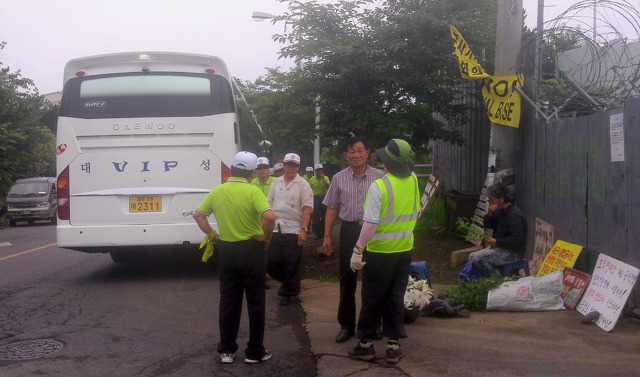
Photo by Save Jeju Now/ Ultra right wing veteran group arrived at the main construction gate. 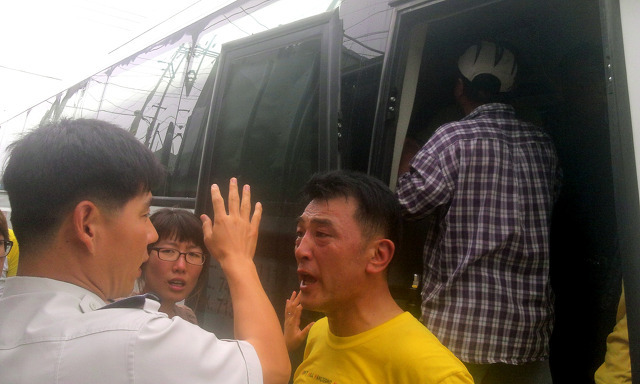
Photo by Save Jeju Now: Mayor argues with Koo Seul-Hwan, director of the Seogwipo Coast Guard 
Photo by Save Jeju Now/ mayor barely stands up after mess. On July 1, Son Jeong-Mok, Vice-chief of the Joint Naval Operation visited Gangjeong for ‘reconciliation,’ saying he wants to talk with both of pro and con base villagers. However, on the very day, two people, Dr. Song Kang-Ho and Br. Park Do-Hyun were illegally taken away and arrested on the sea when they monitored illegal construction (destruction), by the coast guards who should do the very job of monitoring on illegal construction (destruction). A world being reversed too grotesquely.
It was around 1 pm when the people ended the press conference in protest to the illegal arrest of two in the morning and had a break following Catholic mass and human-chaining in front of construction gate. A large size VIP white bus that reads ‘Choongnam branch of the Vietnam War Veterans Association’ (an ultra-right wing group) suddenly stopped in front of main gate and then it vomited its tens of members in a pale green uniform t-shirts.
It was even heard that a thug(so called company ‘security’ guy) said to them that it is not the main entrance but the main gate of the naval base project committee building complex is. Mayor Kang Dong-Kyun who happened to see them strongly protested to their unwelcoming visit to his village. Then some veterans rushed to him and rudely touched their hands to his body, slandering him as “commie”-such astonishing and dangerous situation! It was such suspending and anxious situation from the worry of possible injuries of people!
Please imagine. Not only mayor Kang himself, but many Gangjeong villagers, and Jeju island people have suffered from the unreasonable and violent label of “commie family,” put on them while their innocent members of families and relatives were falsely accused as “commies” and killed during the 4·3 incident. The truth is that they were only innocent farmers or fishermen. Now the Gangjeong villagers who merely aspire to save their hometown suffer from the dual bridles that connect the past and current, being called as “Pro-North Korean” as if a nightmare is revived.
The ghosts of Won Sei-Hoon and the Vietnam War veterans’ such unreasonable and violent remark is a kind of ideological oppression to break down people’s will for peace and democracy. It could be called as ‘psychological military operation.’ During the 4·3 and Vietnam War, the oppressors labeled people as “commies,” and mass massacred them, as if they are following ‘textbook.’ However, the Vietnam War veterans seem not to know that they are also the victims of history by the manipulated ideology. The traces of ROK veterans’ atrocities in Vietnam are still vivid.
In Gangjeong, it is a thing to put nail to the villagers’ hearts that already suffer from the destruction of Gureombi Rock and sea which are like mother’s bosom. Further many villagers feel pain for the news of arrest of two on July 1.
The protest by villagers, including mayor who insisted truthful apology from the veteran who committed such slander, facing the veterans and policemen who attempted to hide the man of remark and to pacify incident, was strong. According to Fr. Kim Sung-Hwan, Koo Seul-Hwan, Security director, and Yang, Intelligence director of the Seogwipo Police Station threatened villagers who were to enter inside bus for protest that they would ‘accuse’ them and said to them they should not do ‘illegal activity.” Fr. Kim points out though, “However they just leave the illegal construction (destruction).”
The policemen eventually forcefully removed villagers who were protesting in front of bus to demand apology and were to make bus enter inside the naval base project committee building complex. The villagers fought hard till 3 pm when the incident ended. Following the arrest of two on the first day of July 1, July 2 was another hard day for the people in Gangjeong. The village siren rang again. Mayor who happened to be surrounded by the policemen fell on the ground and could not be seen of his appearance for a short time, to people’s concern.
The positive thing is that many villagers appeared. The people in the field could more confirm their solidarity will and human love. The people who crave for justice are beautiful and shining.
Maybe the traitors of history forgot the fact that the people rise up for democracy and justice if there is oppression!
As of July 8, 2013,
Yang Yoon-Mo(prisoner No. 301), 158th day of imprisonment and
Kim Young-Jae(prisoner No. 435),88th day of imprisonment.
Dr. Song Kang-Ho and Br. Park Do-Hyun, 8th day of detention in the Jeju Coast Guard. The court made decision to imprison both on July 5.
Release all the conscientious prisoners!
Immediately stop war base build-up of environmental destruction and infringement of human rights!
-
“The Ghosts of Jeju,” being screened with hot response: Please order the DVD
Regis Tremblay, director of the movie, “The Ghosts of Jeju,” wrote on June 29: ‘Bruce Gagnon, my friend and coordinator of the Global Network Against Weapons and Nuclear Power in Space, screened the film for his international board meeting in Sweden this evening (6/29/13). Here are his remarks:
“It was a smashing hit….people were crying and they were clapping at the end…..I handed out the DVD’s strategically to key leaders in various Swedish cities, and from Finland, Norway, Denmark, Germany, Japan and Mexico…..people passed the hat to send money to the village but I insisted they keep the money towards sending a representative from Sweden to the village ASAP……they loved the music, the story, and the resistance…..many people sent congrats to you….it’s was a European opening night showing……5 stars” (source)
See also audience response, in Maine, in May, this year, here. The Ghosts of Jeju is screened at the Grace Episcopal Church in Maine, United States, from 3 to 6 pm, on Sunday, Aug. 18, too.
‘It is SUCH a moving film – strongly recommend it.’ (Lindis Percy)
‘A fantastic movie-I plan to show it at home in Ireland this summer!’ (Fr. Pat Cunningham)
Please order the DVD and spread to your communities.
-
A returned US base in Jeju, proved to be ‘most oil-contaminated,’ will be used again to militarize Jeju?
Re-blog from here
1. McNabb, a returned US base in Jeju, is most oil-contaminated among
16 returned bases in Korea

A radar in the McNabb US base, Moseul Peak, Hamo-ri, Daejung-eup, Seogwipo City, Jeju (source) The Jeju Sori, June 3, 2013, reports that the vicinity soil of a returned US base, McNabb, located in the peak of Moseulpo, Hamo-ri, Daejung-eup, Seogwipo City, Jeju, is seriously contaminated by the oil leaked from the base. The McNabb is one of 16 returned US bases in Korea on July 15, 2006.
It has been the only remaining US base in Jeju until its returning back to Korea.
According to Jeju Sori, the CBS Nocut News reported on June 3 that the degree of TPH (Total Petroleum Hydrocarbon) was measured 42,500 mg/kg, in the vicinity area of the base, as a result of the investigations on basic environment twice, from Oct. to Nov., 2011 and from Dec. 2011 to March 2012.
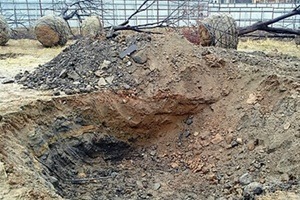
Source: Jeju Sori, June 3, 2013 The article reads:
The number of 42,500 exceeds about 85 times of 500 that is the standard TPH in the area. Its soil contamination by oil is proved out to be most serious among 16 returned bases in Korea, by the investigation by the Ministry of Environment.
The TPH not only brings serious environment contamination. It makes impossible of plant survival itself but also contains poisonous material fatal to human body.
The investigation on environment basis on the 16 returned US bases has been carried out twice respectively from April 2008 to March 2012.
Those 16 US bases are among 23 US bases returned back to Korea in 200[6] and are the bases sold to local self-governing institutions or decided to use for other usage.
Reference:
According to Jang Dong-Hoon, an Island Provincial Council member then, has mentioned on July 25, 2006 that the amount of soil contamination of the whole area of the McNabb base was 2,938 ㎥. The TPH was 17,415 ㎎/㎏, greatly exceeding the standard of 500 ㎎/㎏. He also reported that part of underground water was also contaminated by oil belt.
“According to the report by the Ministry of National Defense in May, the degree of soil contamination of 24 of 27 US bases planned for returning back to Korea, proved out to exceed standard and the underwater contamination of 15 of those are serious.” (Source: Jeju Ilbo news on July 26, 2006)
2. History of McNabb US base
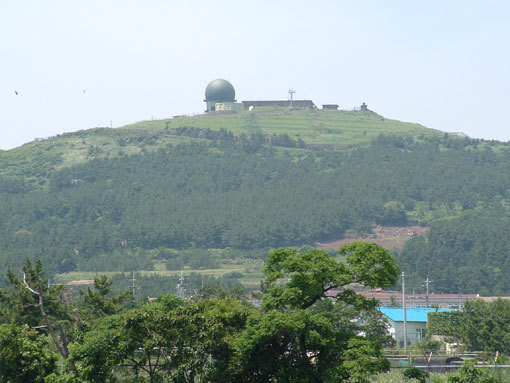
Source: Seogwipo Shinmun, July 15, 2006 The McNabb US base in Moseulpo (*named after captain McNabb, vice-general of Alddre Air field in 1953. Source) was built in 1953 with the creation of ‘UN Air Force Base,’ in 1952.
Its whole size is about 39,000 ㎡ (* You may compare the size with the real area of the Jeju naval base project, which is about 480,000 ㎡). It was actively used as a radar base from 1958 to 1973 and its numbers of working military force used to reach to maximum 150. It was used as guerilla training and rest facility for the soldiers of the Eighth United States Army (* which commands the US Army forces of Korea) and 2nd United States Infantry Division (* which stations in Korea) since the building of the Jeju training center for the Eighth United States Army.
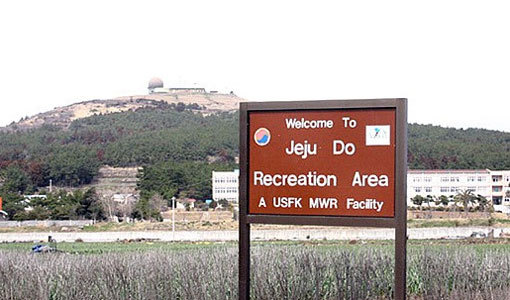
Source: Seogwipo Shinmun, July 15, 2006 However, as the residing US military withdrew from the McNabb base in 1995 and name was changed to the Jeju rest home of the welfare center of the United States Forces of Korea , it was used more as a rest home rather than training center. As four residing managers there were moved to the welfare center of the Eighth United States Army in January 2005, the rest home was closed.
As a result of the 9th ROK-US SPI (Security Policy Initiative) meeting in Seoul from July 13 to 14, 2006, it was returned back to Korea along with other 15 bases nationwide on July 15, 2006. (source: Hankyoreh, July 15, 2006)

The US bases in Seoul, Dongdoochun, Ujungbu, Hanam, Paju and Jeju, returned back to Korea (Source/ Original source; Ministry of Environment) The Island people demanded at the time, “The McNabb base was used as a Japanese base during the Japanese occupation of Korea ( *1910 to 1945) then as the 9th regiment of the ROK National Defense security unit that suppressed the 4.3 uprising during the term of the US Military Government after the liberation of Korea from Japan, then used as the US base for 53 years after the Korean War. It is a vivid site of 100 years’ modern history of Jeju. We hope the facilities can be used in the future to contribute for the image of Jeju, the “Peace Island.” ( Source: Hankyoreh, July 15, 2006)
The government stated on July 14, 2006, that “The 15 US bases nationwide returned back to Korea would be returned back to local self-governing institutes again after the curing of contamination there.”
However, it was about one and half month later that the Jeju Ilbo reported that the Ministry of National Defense stated in relation to the returning of McNabb base that the Ministry would neither transfer nor sell the base to the local self-governing institute (Jeju Island) but the ROK air force would utilize it.
Despite the Island people’s opposition, it was returned back to the Ministry of National Defense on April 13, 2007 and it was decided that the camp McNabb is used by the ROK air force base in April 2008.
At the time, personnel in the US base relocation team of the Ministry of National Defense, clearly stated that “since there has been a ROK air force unit (radar base) inside the camp McNabb, the military’s usage plan on the base has already come out. The Ministry has no plan to sell or hand over it to the Jeju Island.”

Even after the returning back of the base, the area is still restriction-controlled as it is owned by the ROK Ministry of National Defense and used by the ROK air force
(Source: Ohmynews, Dec. 3, 2009)Though the air force headquarter personnel stated that it has no concrete plan on the usage of the base in the future, some suspected that the McNabb base would be a powerful candidate area for the idea of creation of the Jeju unit of the ROK air force search and rescue corps, reflected in the mid term national defense plan from 2007 to 2011.
Anyway, the decision to hand over the McNabb base to the Ministry of National Defense was different from the other returned bases that were handed over to the local self-governing institutes, some of which were to be developed into history or civic parks. (Source: Jeju Ilbo, Aug. 30, 2006)
Such decision also affected to the delay of the basis investigation on environment, in the vicinity areas of provision zones from the US forces of Korea.
The basis investigation on environment on the vicinity areas of Camp McNabb, located in Jeju, was barely carried out at the latter part of 2011, after 4 years since the government measure on it was set up in October, 2007.
Further the investigation target area was also limited. The investigation was to be carried out within 100 m areas from the border lines of air force base. The inner area of military unit became to be excluded from the investigation in 2011, for the reason that the inner area belongs to air force.
And eventually, the result of the investigation turned out that the vicinity of the McNabb base is the most contaminated among 16 returned based, compared to the investigation on soil contamination in 2005 when it was reported that while the inner area of the base was partly contaminated, the outer area of it was not. (Source: Jemin Ilbo, Aug. 18, 2011)
3. Will the McNabb base be used again for militarize Jeju?

Photo by Daniel Kojetin, Jeju Weekly, May 14, 2010/ Image of Olle to the Moseulpo Peak As mentioned above, the returned McNabb base is currently OWNED and managed by the ROK Ministry of National Defense. There has already been a suspicion that the McNabb would be used for the creation of Jeju unit of search and rescue corps, reflected in the mid term national defense plan from 2007 to 2011. The future usage of the base could be very related to the old Alddre Airfield located in the south of it, nearby.
The old Alddre air field has never been completely returned back to the Jeju Island, but owned by the Ministry of National Defense and is suspected to be used for the active military air field if Jeju is to be militarized.

Old Alddre air field, to be suspected to be planned for a new air force base (source) It was the old Alddre air field that mattered along with other 9 articles on April 27, 2009 when Kim Tae-Hwan, ex-governor of the Island signed on Memorandum of Understanding (MOU) Related to the Construction of the Civilian-Military Complex Port for Tour Beauty with the Ministers of National Defense and Land, Transportation and Maritime Affairs then. The MOU itself turned out to be dual in September, 2011 when Kang Chang-Il, Jeju-based National Assembly man disclosed that the title of the document owned by the Jeju Island and Ministry of National Defense (MND) were different.
In the document owned by the MND, the words of ‘Jeju naval base,’ was clear with the words of Civilian-Military Complex Port for Tour Beauty in parenthesis, which made people make sure that the currently enforced naval base project would be PURE military base. For the whole translation of MOU, see here or here.
It was in that fake MOU that the condition on the use of Alddre Airfield was stipulated.
Article 5 (Use of the Alddre Airfield etc.) (1) The Minister of National Defense allows the Jeju Self-Governing Island, through the discussion with the Jeju Self-Governing Island, to use the area of the popularly known as the Alddre airfield that is located in the Daejung-eup, City of Seogwipo and in the jurisdiction of the City of the Ministry of Defense, for the regional development of the Jeju Self-Governing Island, according to the legal procedures. (2) The Ministry of National Defense confirms that he has no plan to deploy fighter airplanes in the Namboo (* meaning ‘southern’) Search & Rescue troop unit of the air force
The old Alddre air filed was built on the wide field under the Songak Mt (84m), Sangmo-ri, Daejung-eup, Seogwupo City, Jeju, by the Japanese military in 1930s. In 2002, it was designated as No. 39 modern age cultural heritage by the ROK government in 2002.
The Japanese built large size military facility in the Jeju Island since 1920s (Some say the beginning year was 1926). The Alddre air filed was completed in Daejung-eup in the middle of 1930s and fighter planes sortied from there bombed Nanjing, China 700 km distance from it in 1937 when the Sino-Japanese War occurred. ( * Therefore some people used to call the Moseul Peak as the Kookje bong meaning ‘international Peak’)
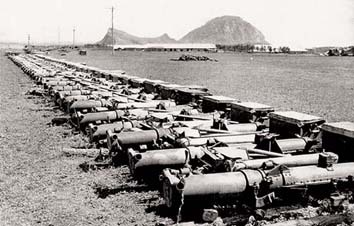
200 mm rockets arranged before the destruction of Alddre air field, Daejung-eup. Moseulpo (source) Total 20 hangars of 20 m width, 4 m height, and 10.5 m length were built there. Akatombo, a training airplane was also secretly stored there. (Source)
The old Alddre air filed is currently a tourist place, part of the route 11 in the Jeju Olle. Many parts of the field are used for farming such as growing potatoes (Jiseul in the Jeju dialect) as the MND has rented the land to farmers. However, the suspicion on its revitalized military usage in relation to the matter of new airport location has been raised at least twice in the National Assembly, by now.

Map of the Olle route 11 (source by the Jeju Island government) 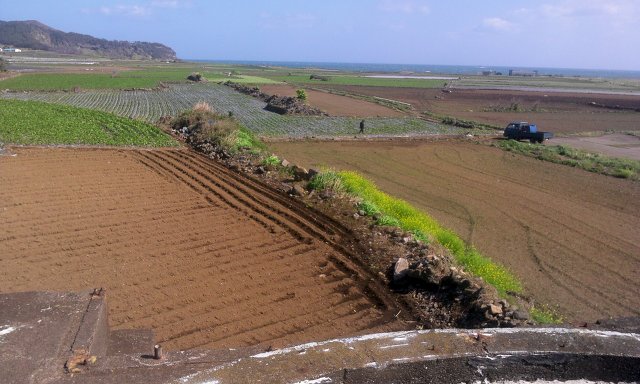
The old Alddre air filed now used for farming (Photo by Save Jeju Now on April 7, 2013) 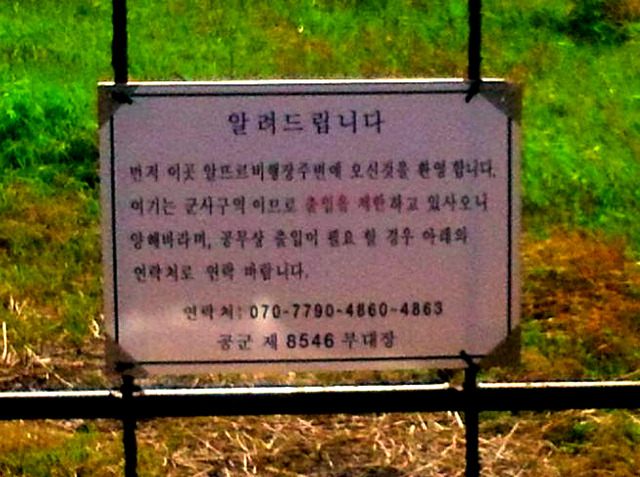
A sign of restriction by the ROK air force. It says it is a military zone. Some people said they couldn’t see it before. Still the visit of the area was OK in April, this year.
(Photo by Save Jeju Now on April 7, 2013)Roh Hoe-Chan, Progressive United Party, has made a remarkable claim in the National Assembly inspection session in May 2007, that “the Ministry of National Defense and Jeju Island have agreed that the Island provides 300,000 pyeong (about 99 ha) to an air force in case the 2nd new air port is built on the condition that the air force concedes the Island old Alddre air field of about 600,000 pyeong (about 198 ha). It meant the Air Force is ready to use the Alddre Air field as an area for the South zone search and rescue corps unit unless the Jeju provides an alternative area to the Air force. (* For reference the Jeju naval base project is of about 48 ha.) (Ohmynews on Sept. 3, 2012/ See here or here for the source of citation)
It was Oct. 18, 2012 again that the issue was raised in the National Assembly inspection on the ROK air force on the ‘South zone search and rescue corps’ that is being discussed to be installed in the old but currently unused Alddre air field, Moseulpo.
Kim Jae-Yoon, Democratic United Party, a member of the Defense Committee of the National assembly claimed that it is a tactic ultimately to build an air force base. He claimed that the Jeju, the Island of peace is at the risk to be degraded as the ‘Island of military base.’
Saying that “when I demanded the air force on the material on the ‘South zone rescue and search corps unit, the air force replied me that it is planning a creation of it for national security and people’s safety,” Kim interpreted that “However, given that rescue and search corps unit is a non-combat corps that is in charge of search and rescue, its words that it creates it for the securing of national security connote that the rescue and search corps unit is, after all, combat corps.”
Will the Jeju be militarized? The matter has already been concerned about. With the recognition on the McNabb base near the Alddre airr field, the issue has to be more considered in coming future.
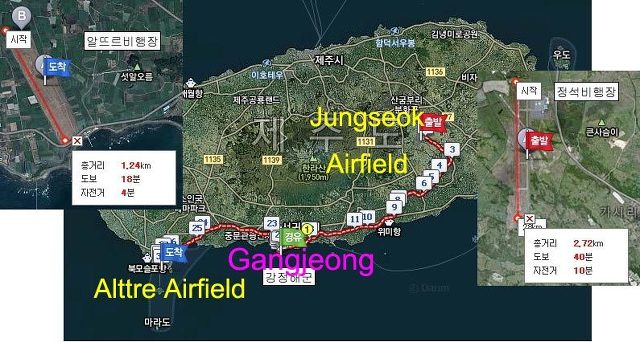
Source of maps: See here or here. (Please change the word of Alttre to Alddre) To remind, it is important to note that the vicinity area in the McNabb base and Alddre air field is one of the big massacre sites of 4.3 period (1947 to 1954)
During the Korean War (1950 to 1953), it was the site where about 210 innocent, many of them in their 20s were brutally killed and buried, stamped as communists and arrested by the vicious law on preliminary detention-the trace of Japanese imperialism- under the US puppet Rhee Syng-Man government. The tragedy of 4.3 was lingering throughout and even after the Korean War. It was only under the civilian government in the 21st century that their honors were finally recovered., with the common tomb nearby cherished by their descendants.
If the Jeju is militarized again and war breaks out in Korea, we will see another repetition of history in Jeju. That is why it is important for us to make efforts for the Jeju to be demilitarized.
For more photos on the massacre site called Seotalorem and the common tomb called Baekjoilsonjimyo (meaning 100 ancestors but one common descendants) , see here.
You may also see
Two killed girls 11 years ago revive the move for the total revision of ROK-US SOFA, upon the 60th year of Armistice Agreement
United States, Stop conspiracy for military control and financial pressure to ROK!
-
Non-violence in times of war: Protest and resilience in Jeju, South Korea
Re-blog from the Intrepid Report

Photo by Cho Sung-Bong/ People take meals during protest in front of construction gates. For more photos of protest by Cho Sung-Bong, see here. Non-violence in times of war: Protest and resilience in Jeju, South Korea
by Carole Reckinger
April 16, 2013
In the midst of warmongering and a worsening of tensions between North and South Korea, a group of peace activists is continuing its non-violent struggle against the construction of a naval base on the island of Jeju, South Korea.
Tensions between North and South Korea are not new and the importance of building the base have been repeatedly put forward by the South Korean government as playing an important role in coastal defense. It claims the naval base must be completed and put into service as soon as possible in order to react quickly to any further military provocations by North Korea.
Since 2007, the small fishing village of Gangjeong has led a non-violent resistance against the construction of a naval base right next to a UNESCO biosphere reserve. Despite 94% of the villagers having opposed the base in a referendum, the government has not respected the wish of the people concerned and seems to be buckling under the pressure of corporate conglomerates and the weight of the United States’ wish for an increased presence in the Pacific.
In November last year, I spent a month in Gangjeong village. Day after day, I observed the disproportionate police reaction to the non-violent blockade of the entrance to the construction site and. The most striking feature of the protest was the protesters’ resilience. Young and old and from a multitude of social backgrounds, despite their bruised bodies, the odds stacked against them and the risk of high fines or imprisonment, they kept returning to the front of the gate to fight for what they believe is right. But since tensions have been rising with the North, police crackdown has become more severe and more protesters have been arrested.
‘Professional troublemakers’
From the time the construction of the base was announced, activists, Catholic priests and nuns, Protestant pastors, law professors, teachers, artists, writers, families and students from all around South Korea have joined the villagers’ protest. In order to hinder and delay construction, protesters file lawsuits and press for a reconsideration of the project nationwide, but also regularly block the entrance to the construction site with their bodies, chain themselves to anything available and go on hunger strikes. The fight against the naval base currently mobilizes more than 125 non-governmental organizations across South Korea and more than a hundred abroad [1].
The reasons for which activists from across South Korea and abroad oppose the base are manifold. They include calls for environmental protection, social justice, demilitarization and non-violence. Support for the anti-base movement at the national level is limited, one reason being that the mainstream media has not picked up the topic. When it has, it has portrayed the activists as troublemakers and has tried to discredit them. In times of heightened tensions with the North, calls for demilitarzation, peaceful resolution of conflict and the protest against military bases are heavily criticized, and the Gangjeong protesters are insulted as undermining the security of the state and being pro-North Korean agitators.
The protest demographics, however, invalidate accusations of professional trouble-making as the movement is composed of housewives, taxi drivers, teachers, farmers and students, from all ages and social backgrounds. Many activists in Gangjeong, are members of pro-disarmament and peace groups/networks, and clearly oppose a militarization of the ‘Peace island.’ When Jeju last hosted a military base in 1948, 30,000 people were killed, 40,000 houses burnt down and 90,000 people made homeless (with a population of 300,000 at the time), as the government sought to quell an uprising led by a small group of alleged communist insurgents.
Only in 2003 did the South Korean government apologize. President Roh Moo-Hyun called the massacre, which became known as the April 3rd incident, a “violation of human rights by the state.” He declared Jeju the “Island of World Peace.” But the official peace rhetoric was short lived. Only four years later, the same President finalized plans for the naval base on Jeju. “We do not understand why South Korea, with more than 100 military installations, still needs another military base,” says the mayor of Gangjeong. “We are not convinced by the argument that this naval base will enhance the security of our country” [2].
The ROK Navy already operates seven naval bases in South Korea and the Republic of Korea Armed Forces is the sixth largest army in the world. [3] Since the end of the Korean War, South Korea has a joint military partnership with the United States through the US-ROK Mutual Defense Treaty. South Korea relies on its security partnership with the United States to protect itself from external threats, most notably North Korea.
A new tactic of discouragement
In the midst of the growing tension between North and South, demilitarisation and peace messages will not be given much space in the national discourse and the mainstream media. The risk is high that security arguments will be used to crack down on the peace workers and smother the years old struggle to an end.
During the long years of dictatorship, dissent and civil disobedience would have been met with bloody repression. Today, the government is not in a position to use such deadly violence on its people and uses other tactics. Since the start of the construction, around 700 arrests have been made with 500 indictments and 22 people imprisoned. However, following the presidential election of Park Geun-hye in December 2012, fines against the protesters have been soaring. The total amount of fines for anti-base protest has reached approximately US$450,000 in addition to damage compensation fees of approximately US$280,000. Between January and mid-February 2013 alone, around 100 people went on trial and were sentenced to combined total fines of US$90,000 [4]. This seems to be the government’s newest tactic to discourage protesters from taking part in the protest. This is a much more discreet but just as effective method of repression.
It is clear that in the eyes of the government, the local community’s livelihood and the natural and human resources on which it depends come second to geo-strategic and corporate economic interests. The current North-Korean military threats will further undermine the nonviolent protest against the militarization of Jeju and the government seems prepared to use all levels of state power to go ahead with the project, from massive executive reinforcement to legal and political measures. With all the media attention focused on the war rhetoric, the fight of the Gangjeong activists is at risk of being forgotten.
Notes
1. Information retrieved from www.savejejunow.org
2. Personal interview conducted 19 November 2012 in Gangjeong, South Korea
3. Quoted in Republic of Korea Armed Forces, Wikipedia entry, Retrieved from www.wikipedia.orghttp://en.wikipedia.org/wiki/Republic_of_Korea_Armed_Forces
4. Gangjeong Village story (feb 2013), severe judicial oppression fought with healing hands
-
“Where there is oppression, there is uprising!”: Another activist to be imprisoned
1. Mr. Kim Young-Jae, a peace activist was illegally arrested and got the arrest warrant.

Photo by Park Yong-Sung/ Mr. Kim Young-Jae was arrested on April 12, 2013. On April 12, Mr. Kim Young-Jae, a dedicated Gangjeong peace activist and a member of the SPARK (Solidarity for Peace And Reunification of Korea) was arrested. He was standing in front of a truck around 1 pm in protest to illegal environment-destroying construction (destruction). His arrest marked the 2nd arrest this year, following the April 8 arrest of Mr. Bae Gi-Chul, representative of the Jeju Pan-Island Committee for the Stop of Military Base and for the Realization of Peace Island (Pan-Island committee afterward). Mr. Bae was released next night.
On April 14, the prosecutors filed for an arrest warrant against Mr. Kim Young-Jae and the Jeju court issued it against him around 2 pm. With prof. Yang Yoon-Mo who hits his 74th prison day as of April 14, 2013, Mr. Kim became another current prisoner. The total numbers of imprisonment became 24.
Mr. Park Young-Sung, a fellow activist, has reported on April 12 that the arrest on Mr. Kim Young-Jae was illegal and unreasonable. He reasoned that:
1. Even though Mr. Kim left the site after the police’s 2nd request for leaving, the police obstinately and illegally arrested him
2. Even though another activist with a sign stayed longer than Mr. Kim, sitting on chair in front of the truck, the police arrested only Mr. Kim.

Photo by Park Yong-Sung on April 12/ Mr. Kim Young-Jae holds a sign It should be mentioned that Mr. Kim Young-Jae has been remarkably dedicated activist responsible for coordinating activists in Gangjeong, as well as being a member of the SPARK that has been targeted by the government for years. He was also one of the five who climbed up to a caisson dock in Hwasoon in protest to naval base construction on the opening day of 2012 WCC (World Conservation Congress) Jeju, Sept. 6, 2012.
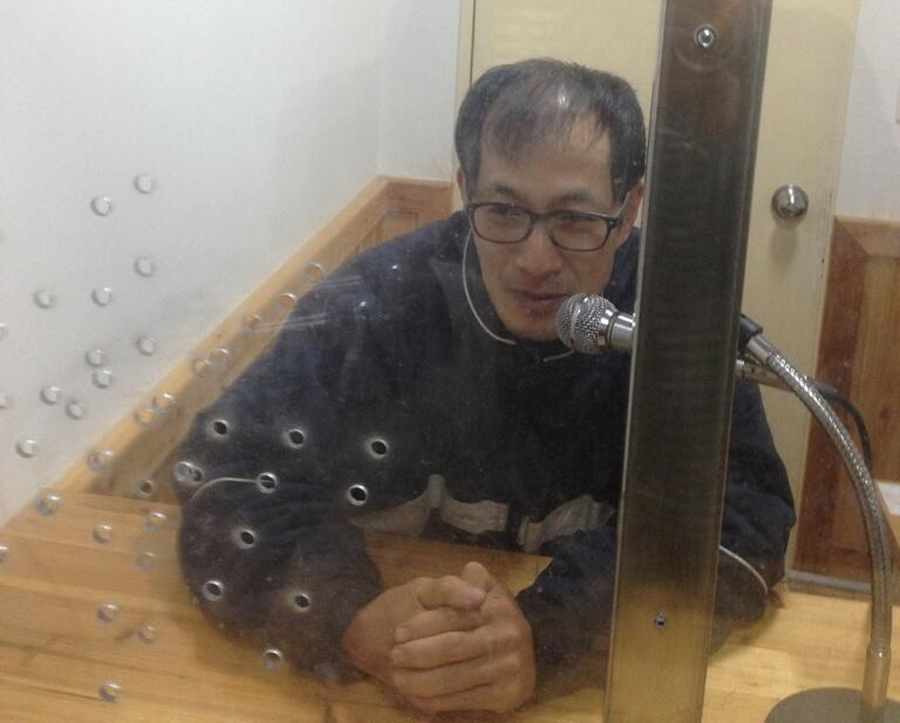
Photo source: Fr. Mun Jeong-Hyeon’s tweeter/ Mr. Kim Young-Jae being detained in the Dongbu Police station, Jeju City on April 14. 2. “Where there is oppression, there is uprising!”
Amid the people’ fury for the arrest of Mr. Kim, a big trailer advanced into a gate of the naval base project committee building complex 30 minutes later of his arrest on April 12. The trailer was ignorant and uncouth to load its heavy weight on a small road in front of gate. There were risks that protesting people might be injured or some of them could be arrested, too…
In the afternoon, there were also Pan-Island committee activists who visited Gangjeong for protest after their press conference in the morning, which was on the environmental destruction for the naval base construction (destruction). The police forcefully encircled them with physical force, too. However, as the words that ‘where there is oppression, there is uprising, stated by people during 4·3 uprising are still remembered by many people, more people will rise up against bigger government oppression . The aspiration for peace would be greater.

On April 12, a big trailer advanced into a gate. For more photos, see here. 
The Pan Island committee’s banner reads, “The Jeju Island government should promptly demand stop on the navy’s illegal construction!
Immediately carry out joint investigation on the ecology affect following illegal construction(destruction)!”
A Jeju activist stops a truck, April 12, 2013 
Police forcefully encircling protesting activists on April 12, 2013 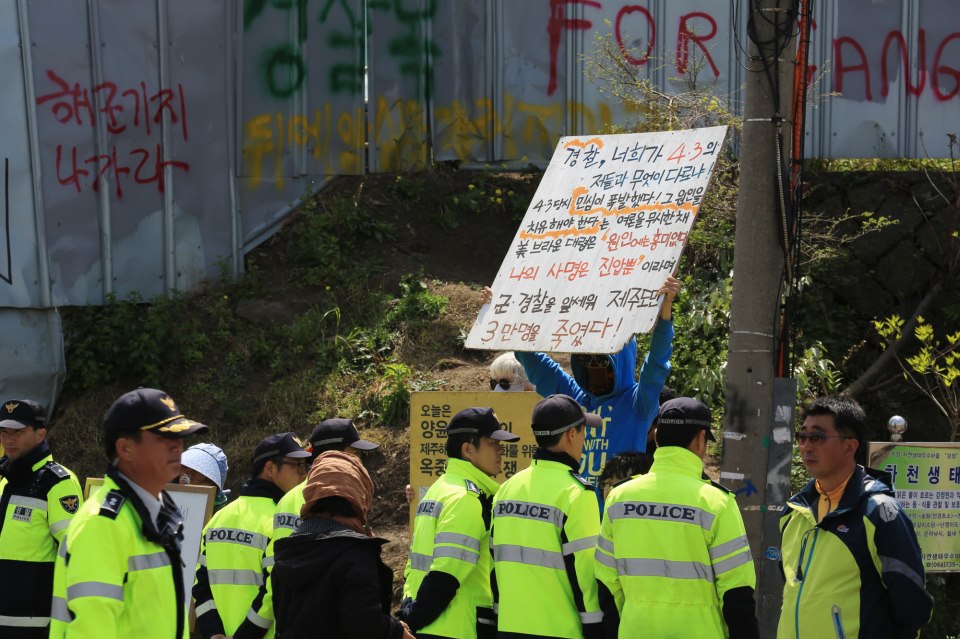
Photo and caption by Cho Sung-Bong (site) / The sign reads… “Police, there can be no difference between you and [the oppression force during the 4·3! At the time of 4·3, people’s public sentiments exploded! Ignoring the public opinion that cause should be healed, U.S. captain Brown (* Commander of the US military of Jeju then) killed more than 30,000 Island people, led by military and police, saying, “ I am not interested in the cause of the uprising. My mission is to crack down only.” 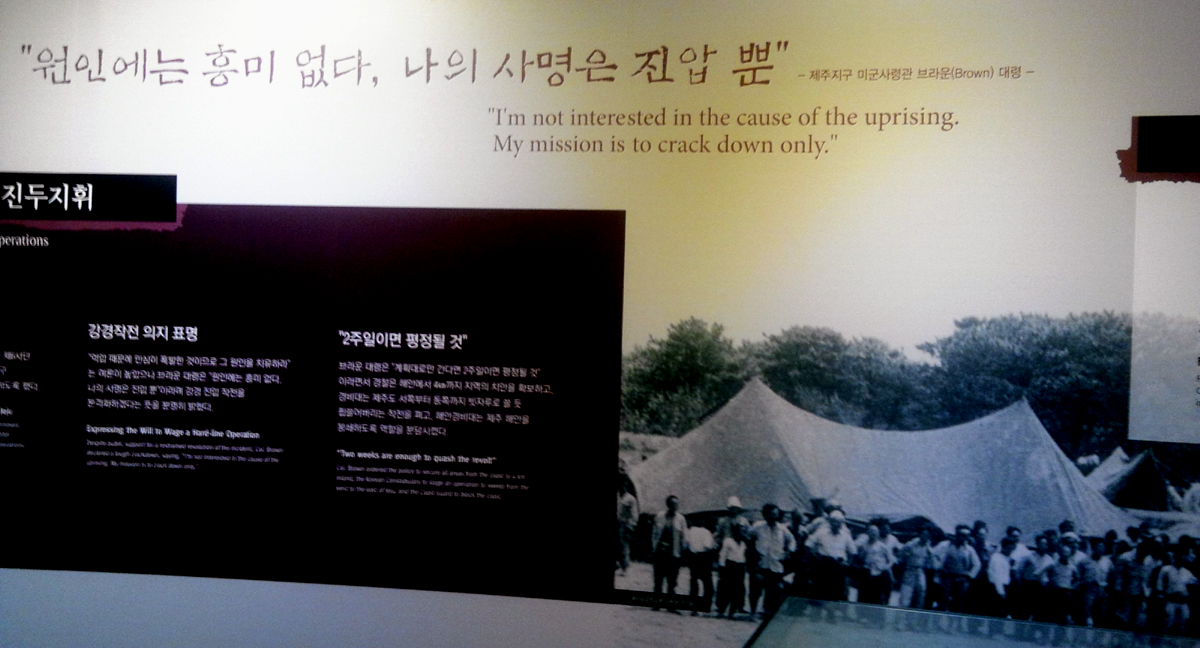
The content is clearly exhibited in the Peace Memorial Hall of the Jeju April 3 Peace Park. Trucks and police were coming every 30 minutes…
(video by Pang Eun-Mi on April 12)

Photo and caption by Cho Sung-Bong/ “How can you endure this tough world without dance?,” she/he asked. You may dance if you love. For more photos by Cho Sung-Bong, see here. 
People who can’t leave the gate.. photo by Cho Sung-Bong. For more photos, see here.
-
The Stations of the Cross on Jeju
Remembering the sufferings of April 3rd massacre. . .These are scenes from a performance held just before Easter on Mar. 29 at Jeju April 3 Peace Park. Members of the Catholic Youth Pastoral Committee enacted the Stations of the Cross, followed by Jesus Christ before his crucifixion. The site commemorates the victims of the Apr. 3 Jeju massacre, which started in 1948. . . . Bishop Peter Kang U-il and many Catholics of Jeju island attended this performance on Good Friday during the Passion week (Post by Regina Pyon)
Re-post from Hankyoreh, April 4, 2013
Scenes from a performance held just before Easter on Mar. 29 at Jeju April 3 Peace Park. Members of the Catholic Youth Pastoral Committee enacted the Stations of the Cross, followed by Jesus Christ before his crucifixion. The site commemorates the victims of the Apr. 3 Jeju massacre, which started in 1948. (by Cho Yeon-hyun, religion correspondent)

